History
"The Prettiest and Fanciest Home on the Boulevard..."
All about The Hill House, aka The Rosalie
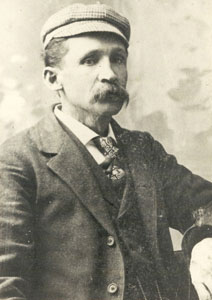 James William "J.W." Hill was born in Pike County, Illinois in 1853 or 1855 (both dates have been published, the earlier date cited by the Hill family). His father, Joseph Hill, was a ship's carpenter who died in 1866 or 1867. His mother, Mary Neal, died six years later. J.W. held a succession of jobs in Illinois, first as a farm hand at the grand salary of $15 a month. He then became a carriage driver for a hotel for three years. J.W. then became a delivery clerk until 1875, when he started a restaurant, which he ran for six years.
James William "J.W." Hill was born in Pike County, Illinois in 1853 or 1855 (both dates have been published, the earlier date cited by the Hill family). His father, Joseph Hill, was a ship's carpenter who died in 1866 or 1867. His mother, Mary Neal, died six years later. J.W. held a succession of jobs in Illinois, first as a farm hand at the grand salary of $15 a month. He then became a carriage driver for a hotel for three years. J.W. then became a delivery clerk until 1875, when he started a restaurant, which he ran for six years.
On October 7, 1879, he was united in marriage with Rachel Ann "Annie" Harshman, of Illinois, who bore to him one son, Emmett. Annie died about a month after giving birth to Emmett, on July 27, 1880. J.W. left his infant son with Annie's uncle. Emmett remained with the Harshman family for the rest of his life, and is buried next to his mother in Griggsville, Illinois.
J.W. moved to Eureka Springs to start anew. There are conflicting dates for this move that have been reported in various publications-- 1879 and the more likely late 1880 or early 1881 based on his "six years" of restaurant work that started in 1875. He purchased a team of horses and a carriage, starting the Crescent Livery and Eureka Transfer Company. After one year, he added a second team and carriage, transporting people and mail from the railroad stations in Seligman and Ozark, Missouri to Eureka Springs.
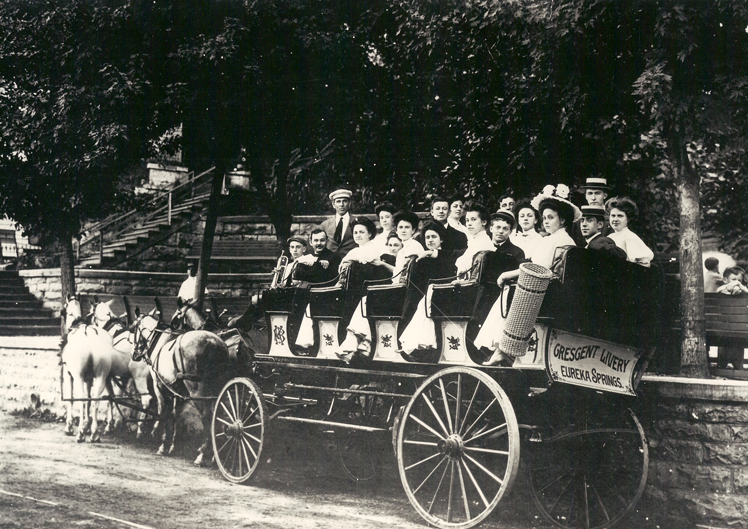 The business grew quickly, and J.W. secured a franchise to supply transportation between the area hotels and the railroad. He also had a contract with the Postal Service and express company. J.W. 's company also provided sight-seeing tours on "Tally-Ho's", large carriages with "stadium" seating that gave everyone a grand view of Eureka Springs' sights.
The business grew quickly, and J.W. secured a franchise to supply transportation between the area hotels and the railroad. He also had a contract with the Postal Service and express company. J.W. 's company also provided sight-seeing tours on "Tally-Ho's", large carriages with "stadium" seating that gave everyone a grand view of Eureka Springs' sights.
In November 1883 J.W. was married, in Chicago, to Ada M. Foster, of that city. Ada was the daughter of Charles Foster, a well known newspaper publisher. Ada and J.W. Hill had four children-- Leila, Lucas Van Allen, James "Jay" Wilson and Ralph Brownell.
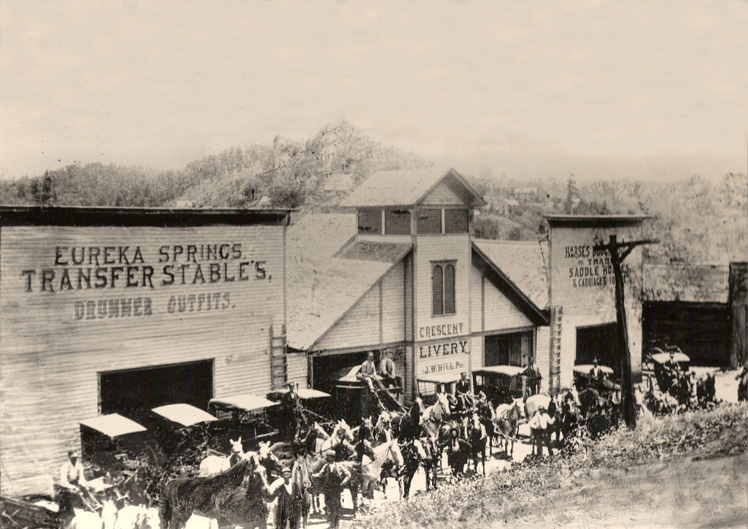 In 1886, J.W. built his stable and livery offices, and enlarged them the next year. They eventually measured 96 feet by 70 feet in depth, and could house 53 horses. Forty horses were used in the livery business. At the time J.W. was described as having "the largest capital investment of any single individual in the city".
In 1886, J.W. built his stable and livery offices, and enlarged them the next year. They eventually measured 96 feet by 70 feet in depth, and could house 53 horses. Forty horses were used in the livery business. At the time J.W. was described as having "the largest capital investment of any single individual in the city".
In 1888, Mrs. AM Foster (Ada's Mother and J.W. 's mother-in-law) purchased Lots 1 & 2, Block 35 of the Clayton Survey. In 1889, J.W. Hill bought the lots from his mother-in-law, and built the first brick home located on upper Spring Street (back then known as "The Boulevard").
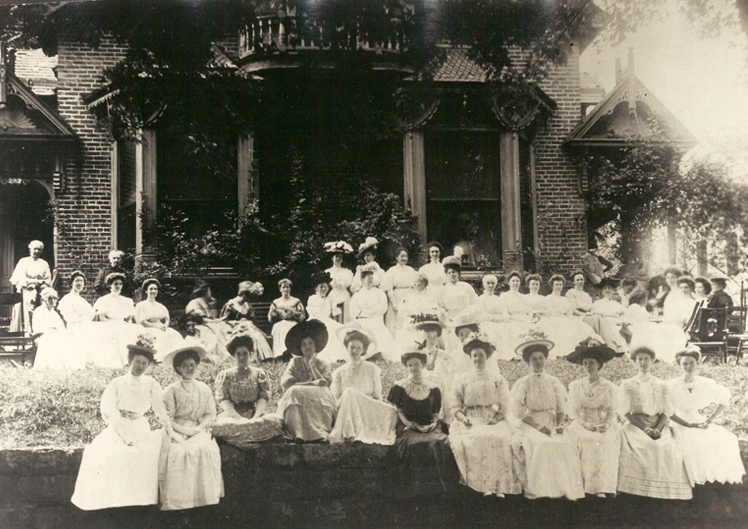 The house was constructed of bricks fired on site, and wood imported from New York. A combination of Steamboat Gothic and Eastlake architecture, the house was declared by J.W. to be "the prettiest and fanciest home on The Boulevard." It was reported that J.W. spent $17,000 building The Rosalie at a time when the average house in Eureka Springs cost between $500 and $1000.
The house was constructed of bricks fired on site, and wood imported from New York. A combination of Steamboat Gothic and Eastlake architecture, the house was declared by J.W. to be "the prettiest and fanciest home on The Boulevard." It was reported that J.W. spent $17,000 building The Rosalie at a time when the average house in Eureka Springs cost between $500 and $1000.
There is a controversy regarding the year The Rosalie was built, as the house had a sign on it that stated "1883". Published dates have included 1883, 1887, and 1889, which we believe is the correct date. It is hard to believe that J.W. Hill built the house five years before his mother-in-law purchased the land on which it was built. Also, the documentation submitted when Eureka Springs was designated a National Historic District shows a build date of 1889.
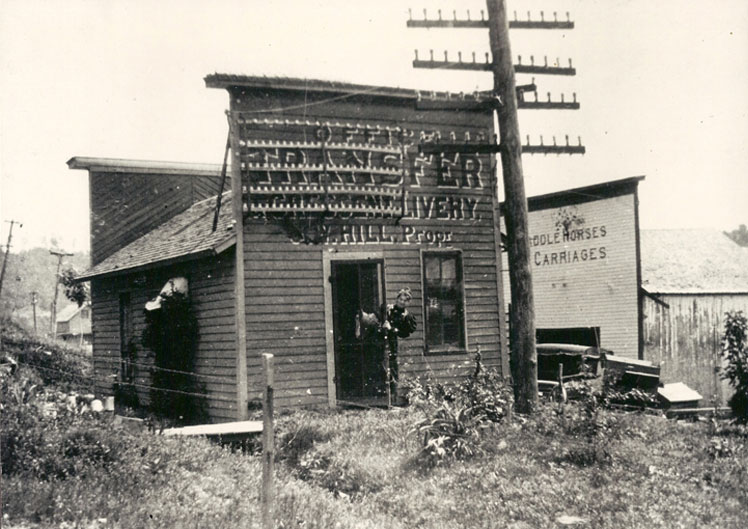 In 1893, Mr. Hill attended the World's Columbian Exposition in Chicago, where the telephone was exhibited. Realizing its potential, J.W. came back and built a private telephone system between his home, the Crescent Hotel and the stables. J.W. used the system to schedule the carriages, replacing runners that previously had to go up and down the hills to see how many people needed transportation to and from the railroad. J.W. then got a franchise from Eureka Springs and expanded the system, making it one of the earliest cities to be fully serviced by phones. At the time, there were less than 300,000 phones in America. Contrary to urban legend, the switchboard office was located on Hillside in a building near J.W. 's stables, not in The Rosalie.
In 1893, Mr. Hill attended the World's Columbian Exposition in Chicago, where the telephone was exhibited. Realizing its potential, J.W. came back and built a private telephone system between his home, the Crescent Hotel and the stables. J.W. used the system to schedule the carriages, replacing runners that previously had to go up and down the hills to see how many people needed transportation to and from the railroad. J.W. then got a franchise from Eureka Springs and expanded the system, making it one of the earliest cities to be fully serviced by phones. At the time, there were less than 300,000 phones in America. Contrary to urban legend, the switchboard office was located on Hillside in a building near J.W. 's stables, not in The Rosalie.
Ada Hill died in 1901. She was 34 years old. J.W. Hill died in 1903. He was either 48 or 50 years old. In his will, J.W. left his estate to four of his children (those from his second marriage), with the provision that 20 percent of his income would be paid to Mrs. Ada Foster, his mother-in-law, who he also named as his children's guardian. He left Emmett, his son from his first marriage, the token sum of $1.00. Ada's aunt, Mrs. Emma F. Van Allen, was named executrix of the estate, and took charge of rearing the children.
In 1910, Mrs. Foster filed an affidavit disputing the will, stating that she alone owned the house, and had made all payments on it. The probate court judge disagreed, and on July 27, 1910 he awarded the children ownership of the house, and ordered Mrs. Foster to vacate the house. The court ordered the children to pay Mrs. Foster one fifth of the income from the J.W. Hill Telephone System, with a minimum payment of $30 per month.
On November 28, 1914 J.W.'s children sold the house to CW Longcoy. On May 31, 1915 Mrs. Foster went back to the court, claiming she had been shorted income from the telephone company, and asked for a lien on the house to prevent the heirs from delivering title to the Longcoys. Mrs. Foster once again claimed ownership of Lots 1 and 2, saying "that claiming in reality she is the owner of said Lots...". The case was dismissed on October 29, 1915.
The Post-Hill Years
Since then, there have been a succession of owners, including Claude and May Fuller (who owned the home north of The Rosalie) in 1917, Lizzie Watkins in 1920 (who passed the house on to her heirs), the Kidds in 1946, the Perebooms in 1972, the Johnsons in 1995, and Michelle McDonald in 2000. One "sale" that has been mentioned in other published reports, to Marie Dobbins, was really just a paperwork formality to change the Kidds' ownership of the property to a joint survivorship. The Kidds' "sold" the house to Marie on July 5, 1968, who then immediately "sold" it back to the Kidds.
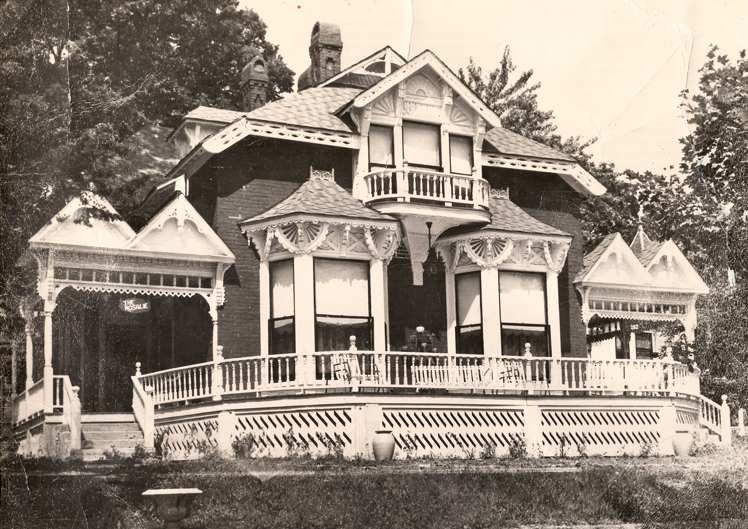 The Perebooms renamed The Hill House to The Rosalie Tour and Weddding Home after visiting The Rosalie Mansion in Natchez, Mississippi. The Rosalie Mansion is owned and operated as a tour home by the Daughters of the American Revolution, and the Perebooms thought renaming The Hill House would help increase their tour and wedding business.
The Perebooms renamed The Hill House to The Rosalie Tour and Weddding Home after visiting The Rosalie Mansion in Natchez, Mississippi. The Rosalie Mansion is owned and operated as a tour home by the Daughters of the American Revolution, and the Perebooms thought renaming The Hill House would help increase their tour and wedding business.
The current owners are Charles and Lori Ragsdell, who purchased The Rosalie on December 21, 2007. They are committed to preserving and rehabilitating The Rosalie. Renovations over the years have included new hi-efficiency heating and air-conditioning systems, a new cedar roof, an updated kitchen, extensive interior and exterior repairs, and a new coat of paint inside and out.
Lori and Charles are dedicated blues music lovers and have helped produce dozens of music festivals over the years. They are also long-time supporters of Turpentine Creek Wildlife Refuge, which provides lifetime refuge to abused, neglected and abandoned lions, tigers, cougars, and other animals. Charles was a board member for over a decade, and served as its chairman during some of their most important rescues, including the Colorado Project.
Changes Over The Years
 There have been many changes to The Rosalie over the years. A major one was the expansion of the porches. Originally the porches had one peak, and were doubled in size.
There have been many changes to The Rosalie over the years. A major one was the expansion of the porches. Originally the porches had one peak, and were doubled in size.
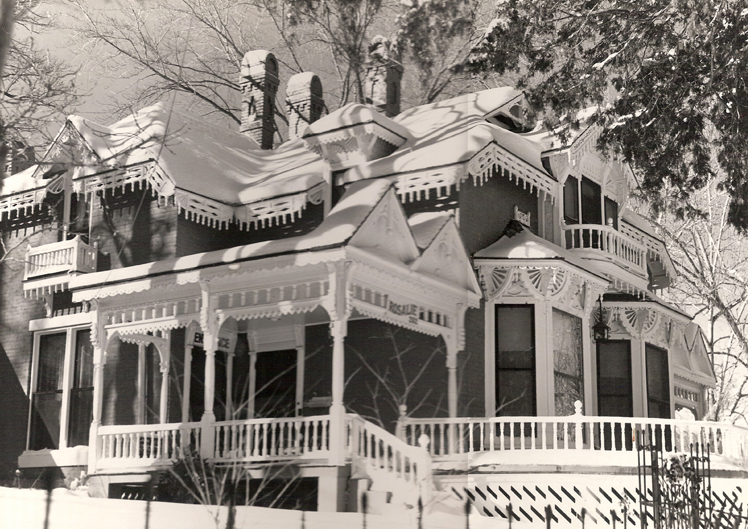 Then the back porches were expanded further and enclosed. There was also a huge wrap-around front porch that was added and later removed.
Then the back porches were expanded further and enclosed. There was also a huge wrap-around front porch that was added and later removed.
One change was the stairwell to the second floor. It originally went from the back of the house to the middle of the hallway, and was rebuilt into the grand staircase you see today. Evidence of this change was found by a previous owner during renovations.
Another major change was merging the two front parlors into one. When first built, there were two parlors, one for the ladies, one for the men, with a pocket door between. During earlier renovations, the center wall was removed to create a huge double parlor.
Another change is the name itself. It was originally called "The Hill House". The Hill children, however, called it "The Gingerbread House" for all the intricate trim work. The Perebooms renamed it to "The Rosalie House" after visiting The Rosalie Mansion in Natchez in the 1970's.
One question people often ask about The Rosalie is "Why isn't the garage symmetrical?" In 1947, the Kidds built the garage and a patio, which became the subject of a lawsuit with their neighbors, Claude and May Fuller in 1954, when the Kidds built a fence on the bluff above the garage. The Fullers went to court, maintaining the garage encroached on the 12 foot easement driveway they had kept when selling the house and lots to the Watkins. The court agreed, and said the Kidds must remove the fence.
However, the court also ruled that the Kidds had "adverse possession" of the land since the Fullers hadn't complained in the seven years since it was built. The court ruled the Kidds could leave the building, but must pay the Fullers for the land they had encroached upon. While the court was waiting to hear motions as to the price for that 125 square feet of land, the Kidds literally sawed off part of the garage! The court then ruled there was no payment due since the building was no longer on the Fullers' land, and denied the Fuller's request for vacating the easement and attorney fees.
And that is why the garage looks like part of it is missing-- IT IS!